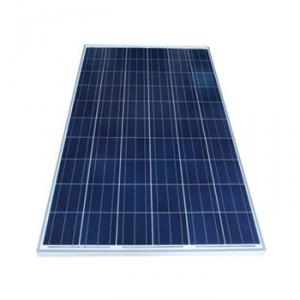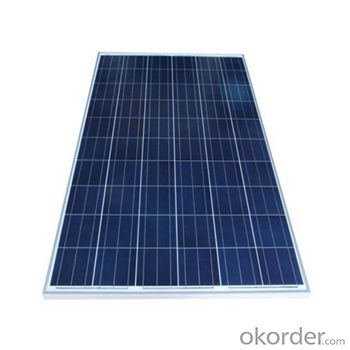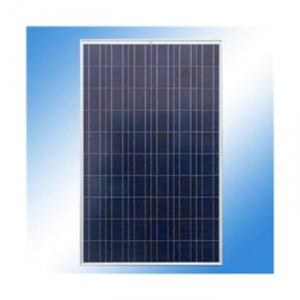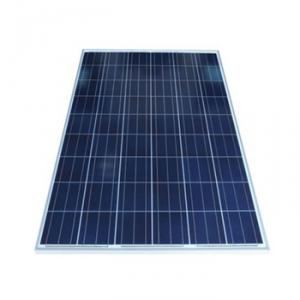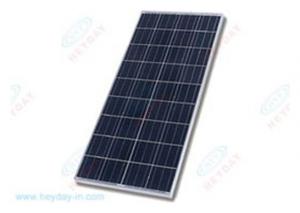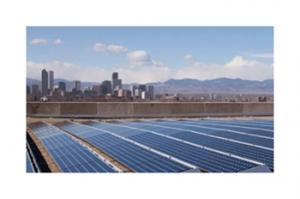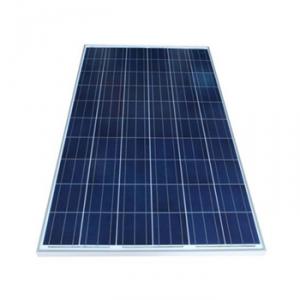Solar Inverter Victron Compatible Poly-Crystalline 240W 156*156 Solar Modules
- Loading Port:
- China Main Port
- Payment Terms:
- TT or LC
- Min Order Qty:
- -
- Supply Capability:
- -
OKorder Service Pledge
OKorder Financial Service
You Might Also Like
Solar Module Descriptions:
Solar Power Modules (known as Photovoltaics - PV) can generate electricity for your home or business, either as part of a stand-alone solar power system, or for buildings already connected to the local electricity network.
PV systems use the most abundant energy source on the planet, solar radiation, to generate electricity. They are silent, consume no fuel and generate no pollution. They also contribute to the reduction of greenhouse gas emissions; a 2kW PV system on a house will prevent the emission of about 40 tonnes of CO2 during its projected 30 year lifetime. Furthermore, the use of PV will reduce your electricity bills and exposure to fluctuating and steadily rising electricity prices.
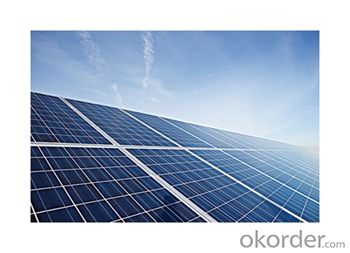
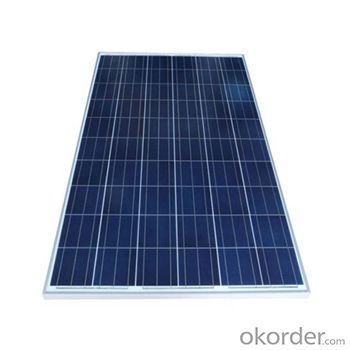
Electrical Characteristics
Max-power (W) | 240 |
Max-Power Voltage (V) | 30.10 |
Max-Power Current (A) | 7.97 |
Open-Circuit Voltage (V) | 37.30 |
Short-Circuit Current (A) | 8.49 |
Mechanical Characteristics
Cable type, Diameter and Length | 4mm2, TUV certified, 1000mm |
Type of Connector | Compatible with MC4 plug |
Arrangement of cells | 6*10 |
Cell Size | 156*156 |
Dimension | 1580*1069*45 |
Weight | 19.5Kg |
Glass, Type and Thickness | High Transmission, Low Iron, Tempered Glass 3.2mm |
Features
Guaranteed positive tolerance 0/+5w ensures power output reliability
Strong aluminum frames module can bear snow loads up to 5400Pa and wind loads up to 2400Pa.
Excellent performance under low light environments (mornings evenings and cloudy days)
12 years for product defects in materials and workmanship and 25 years for 80% of warranted minimum power.
Certifications and standards: IEC 61215.
Manufactured according to International Quality and Environment Management System (ISO9001, ISO14100).
FAQ
Q: When do I need a charge controller and why?
The safest way to figure out if you need a charge controller is to take Battery Amp Hour Capacity and divide this by the Solar Panel max. power amp rating. If the quotient is above 200, you don't need a controller. If the number is less than 200 than you need a controller.
For example if you have a 100 amp hour battery and a 10 watt panel, you take 100 and divide it by .6 (600mA) and you get 166.6. Since this is less than 200 you need a charge controller. If you have a five-watt panel in the above example you take 100 divided by .3 (300mA) and you come up with 333.3. Since this is larger than 200 you do not need a charge controller. However you still need a blocking diode, to prevent the battery from discharging to the panel at night. So as a general rule of thumb you don't need a charge controller unless you have more than five watts of solar for every 100-amp hours of battery capacity.
Q: What is PV & how does it work?
PV stands for photovoltaic. Photo = Light and Voltaic = Electricity. A solar cell converts light to electricity.
A solar cell is made of silicon. Computer chips are made of this same material. Basically, when light strikes the surface of a solar cell some of it is absorbed into the silicon. This light energy bumps the electrons loose and causes energy to flow.
By packaging approximately 36 solar cells together a solar panel or a solar module is created. When you have more then one solar panels you create a solar array.
- Q: Can a solar inverter be used with concentrated solar power systems?
- Yes, a solar inverter can be used with concentrated solar power systems. Concentrated solar power systems use mirrors or lenses to concentrate sunlight onto a receiver, which then converts the solar energy into heat or electricity. This generated electricity needs to be converted from direct current (DC) to alternating current (AC) for use in the electrical grid or to power appliances. A solar inverter performs this function by converting the DC output of the concentrated solar power system into AC power.
- Q: How does a solar inverter handle voltage fluctuations from the solar panels?
- A solar inverter handles voltage fluctuations from the solar panels by employing a technique called Maximum Power Point Tracking (MPPT). The MPPT algorithm continuously monitors the voltage and current output of the solar panels and adjusts the operating point to ensure maximum power transfer. This allows the inverter to adapt to varying sunlight intensity and temperature conditions, efficiently converting the DC power generated by the panels into standard AC power. The inverter also incorporates voltage regulation and protection mechanisms to ensure stable and safe operation despite any voltage fluctuations.
- Q: What is maximum power point tracking (MPPT) in a solar inverter?
- The technique known as maximum power point tracking (MPPT) is employed in solar inverters for the purpose of optimizing the power output of a photovoltaic (PV) system. When solar panels are exposed to sunlight, they generate electricity, but the amount of power they produce can vary depending on factors such as temperature, shading, and the angle at which sunlight strikes them. The maximum power point (MPP) is the specific point at which a solar panel generates the greatest amount of power given the prevailing environmental conditions. However, because these conditions are constantly changing, it is crucial to continuously track the MPP in order to ensure that the solar panels achieve the highest possible power output. Solar inverters equipped with MPPT functionality employ advanced algorithms and electronics to continuously monitor the voltage and current output of the solar panels. By dynamically adjusting the operating voltage and current to align with the MPP, the MPPT inverter ensures that the solar panels operate at their most efficient, regardless of how the environmental conditions may change. When the solar panels are functioning at their MPP, the MPPT inverter extracts the maximum amount of power from the panels and converts it into usable AC power. This optimization leads to increased overall energy generation and maximizes the return on investment for solar power systems. In addition to enhancing efficiency, MPPT also provides other advantages. It can compensate for fluctuations in solar irradiation, temperature, or shading that might impact the power output of the panels. By continually tracking the MPP, the MPPT inverter adjusts the operating parameters to minimize the impact of these factors, ensuring a consistent and optimal power output. In summary, MPPT is a critical feature in solar inverters as it maximizes the power output of a PV system by continuously tracking and adjusting the operating parameters to align with the MPP. This technology enables solar power systems to operate at their highest efficiency, enhance energy generation, and maximize the benefits of utilizing renewable energy sources.
- Q: What is the maximum AC voltage that a solar inverter can provide?
- The maximum AC voltage that a solar inverter can provide typically depends on the specific model and its specifications. However, in general, most solar inverters are designed to produce a maximum AC voltage of around 240 volts in residential installations and up to 480 volts in commercial or utility-scale installations.
- Q: Can a solar inverter be used in regions with extreme weather conditions?
- Yes, a solar inverter can be used in regions with extreme weather conditions. However, it is important to choose an inverter that is designed and rated for the specific weather conditions of that region. For example, there are solar inverters available that are built to withstand high temperatures, extreme cold, humidity, and even harsh weather events such as hurricanes. It is crucial to consider the environmental factors and select an inverter that is suitable for the specific climate conditions to ensure optimal performance and longevity.
- Q: Can a solar inverter be used in parallel configurations for increased power output?
- Yes, a solar inverter can be used in parallel configurations for increased power output. By connecting multiple inverters in parallel, the overall power output can be increased, allowing for the utilization of larger solar arrays and maximizing the energy generation capacity.
- Q: How does a solar inverter communicate with other devices?
- A solar inverter communicates with other devices through various communication protocols such as Wi-Fi, Bluetooth, Ethernet, or RS485. These protocols allow the inverter to connect and exchange information with devices such as monitoring systems, smart meters, or home automation systems. This communication enables real-time monitoring, data logging, and control of the solar energy system.
- Q: How does a solar inverter affect the overall energy consumption of a property?
- A solar inverter plays a crucial role in converting the direct current (DC) electricity generated by solar panels into alternating current (AC) power that can be used to power appliances in a property. By efficiently converting solar energy into usable electricity, a solar inverter helps reduce the property's reliance on grid-supplied electricity. This, in turn, leads to a decrease in overall energy consumption as the property utilizes more clean and renewable solar power rather than drawing solely from the grid.
- Q: What is the difference between a string inverter and a microinverter?
- A string inverter is a central inverter that converts the DC power generated by multiple solar panels connected in series into AC power. On the other hand, a microinverter is a smaller inverter that is attached to each individual solar panel, converting the DC power generated by each panel into AC power. The main difference is that string inverters are used for multiple panels, while microinverters are used for individual panels.
- Q: How do you choose the right size of solar inverter for a system?
- To choose the right size of solar inverter for a system, several factors need to be considered. Firstly, you should determine the total capacity of the solar panels in the system. The inverter's maximum input power rating should be equal to or slightly higher than the total capacity of the panels. Additionally, the inverter's voltage rating should match the system's voltage requirements. It is also crucial to consider the inverter's efficiency, as a higher efficiency rating will ensure better conversion of solar energy into electricity. Lastly, it is advisable to consult a professional or use online calculators to accurately determine the appropriate size of the inverter based on the specific needs and requirements of the system.
Send your message to us
Solar Inverter Victron Compatible Poly-Crystalline 240W 156*156 Solar Modules
- Loading Port:
- China Main Port
- Payment Terms:
- TT or LC
- Min Order Qty:
- -
- Supply Capability:
- -
OKorder Service Pledge
OKorder Financial Service
Similar products
Hot products
Hot Searches
Related keywords
